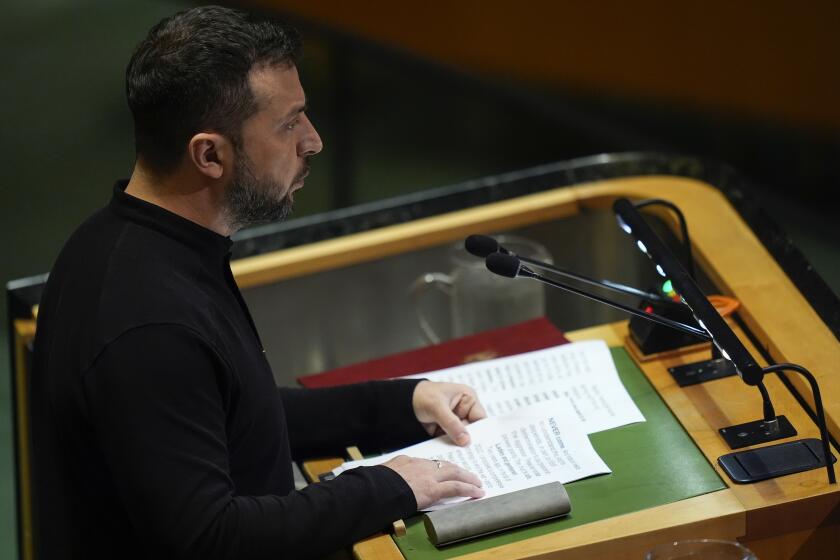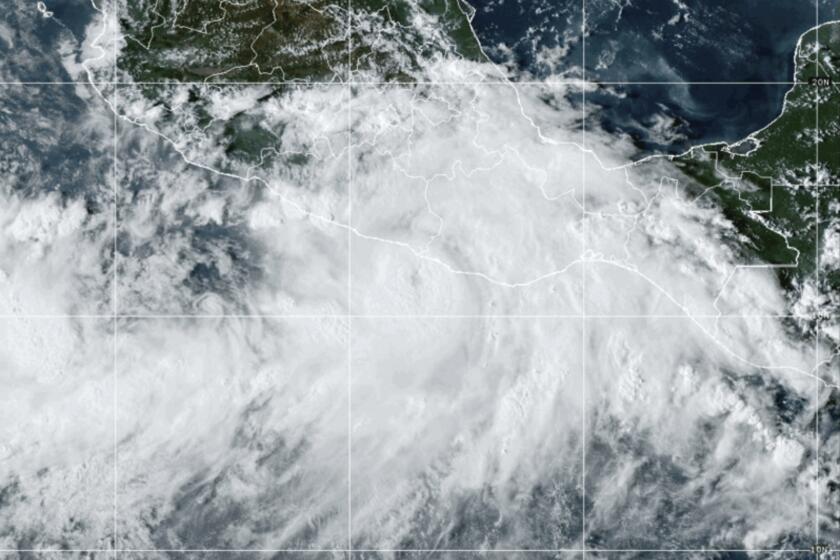Evelyn ‘Tonie’ Seger, 95; Keeper of Tunnel in the Mojave Desert That Became a Tourist Draw
For 40 years, Evelyn “Tonie” Seger lived on a remote mountain ledge 20 miles west of the old Mojave Desert mining town of Randsburg. Her five-room cabin is eight miles from the nearest highway and reachable only by a dirt road.
“My sister keeps telling me: ‘Why don’t you sell that place and get back to civilization?’ ” Seger said in a 1974 interview with The Times.
But Seger never moved off Copper Mountain. As she told The Times, “Somebody has to take care of the tunnel.”
Seger, 95, died May 30 of congestive heart failure in her cabin, which is only 120 yards from the man-made attraction on her property that has drawn visitors from as far away as Russia and Japan: “Burro” Schmidt’s Tunnel.
William Henry “Burro” Schmidt, an eccentric prospector who located 24 claims in the surrounding El Paso Mountains, spent 32 years single-handedly tunneling half a mile through Copper Mountain. He removed an estimated 2,460 cubic yards of rock and did it with only a pick, hammer, hand-held drill and dynamite.
He began digging the tunnel in 1906 as a shortcut for transporting ore to the nearest railroad.
But even after a new road and railroad track made his tunnel unnecessary, Schmidt continued burrowing until, as Seger put it, “he saw daylight” in 1938.
Schmidt died in 1954 at age 82, a decade after Ripley’s “Believe It or Not” called his 2,087-foot tunnel “the greatest one-man mining achievement in history.”
A plaque later placed next to the tunnel entrance by a historical association calls the tunnel “a monument to determination and perseverance.”
Seger hadn’t heard of Schmidt before she and her third husband, Milo Seger, bought the property in 1963 and moved into their small cabin, which was built by the previous owner, who had purchased the land from Schmidt.
“My husband was dying,” Seger told The Times. “The doctor said the high desert was the best place for his health. We bid on 800 acres of raw desert, sight unseen, at the probate court in Bakersfield. The price was $5,000.”
The Segers, who were then living in Huntington Park, “gave up a beautiful home, a beautiful car, for a tired old truck and this ... place,” she said.
Less than a year after they moved in, Seger’s husband died while they were filling water containers from a spring three miles away.
But the Fairfield, Vt.-born Seger, a retired Navy nurse who had traveled widely, chose to continue living in the cabin, which is about 60 miles east of Bakersfield.
Over the years, she tried her own hand at mining. And despite her isolation, she never lacked company.
“Burro” Schmidt’s Tunnel -- Schmidt got the nickname because he dug his tunnel with the help of his two burros -- has attracted tens of thousands of visitors.
As many as 50 on a good weekend show up to take self-guided tours of the tunnel and the one-room plank shack that Schmidt called home for 45 years.
(The walls and ceiling are still insulated with vintage newspapers and magazines and Aunt Jemima pancake mix boxes.)
Although donations are not required, visitors would leave anywhere from a quarter to $5 for the tour, which included a lecture by Seger, who also wrote a profile of Schmidt for the book “Odd and Eccentric People.”
As the keeper of the tunnel for 40 years, Seger became as much a high-desert character as old Burro himself.
“She became so well known as the Tunnel Lady and the Old Lady on the Hill that people actually came to see her,” said David Ayers, a friend of Seger’s who served as her caretaker for three years.
“Even during her last three years here when she couldn’t get outside and do the lectures she did the last 37 years, people would almost demand to see Tonie,” said Ayers, speaking by cell phone from Seger’s cabin. “There was nobody else like her.”
Not surprisingly, the media took an interest in both the tunnel and Seger.
In recent years, Huell Howser, host of the PBS program “California’s Gold,” dropped by. So did crews from two central California TV stations and the History Channel program “Secret Passages.”
“Tonie would always, in a sly way, say, ‘What do they see in that tunnel? Why don’t they leave me alone?’ But I could always tell she loved it,” Ayers said.
A truck driver, he met Seger 20 years ago while exploring the high desert in his 4-by-4.
“Like everybody else, I thought it was so unusual seeing an old woman up here,” he said. “I’ve seen desert rats before, but they’re always men. She was a totally different kind of woman.”
Like the other tourists who make the trek to the tunnel, Ayers said, he quickly discovered that Seger “was one woman you don’t want to get angry at you.
“She just had this air about her: You figure a woman living up here by herself has to be one strong woman, and women’s lib had nothing to do with this. She always laughed at women’s libbers. If they wanted to see women’s lib, they could come out here and see how a real strong woman lived.”
Seger, Ayers said, referred to herself as “nasty-nice.”
“She could be as nice as she wanted to be, but she could be as nasty as she wanted to if that was called for,” he said.
“She’d always tell me and others that one of these days she was just going to walk away from the property and never look back. But she could never do it. Basically, she did love the place.”
As her caretaker, Ayers had to “promise she would die in her own bed in her own house, and that she did,” he said.
Seger is survived by a daughter, Barbara Corbett; a son, Henry Dufresne; 15 grandchildren; 12 great grandchildren; and one great-great-grandchild.
A public memorial service will be held at the tunnel at 11 a.m. Saturday.
More to Read
Sign up for Essential California
The most important California stories and recommendations in your inbox every morning.
You may occasionally receive promotional content from the Los Angeles Times.










